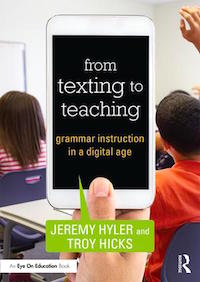Teach Students to Write for Real-Life Contexts
As any language arts teacher knows, once the students have the basics down with the different parts of speech, then they can start creating and crafting some miraculous sentences.
I explain to my 7th graders that sentences can be similar to putting together a puzzle where you are fitting words, phrases, and clauses together. The difference with sentences is that there is more than one way to put the puzzle together and it can always be changed.
Playing with formal and informal sentences gives students the chance to explore several digital spaces in which they could potentially see and use different types of sentences and explore where formal or informal writing might be most appropriate.
The ways in which we use various technologies to compose is both a function of the technology itself and the social context in which it is used. For instance, Twitter, by its limited number of characters (increased from 140 to 280 but still word-stingy) forces us to be clear and concise.
In my classroom, I ask for student input on the spaces where they converse in the most. Toward the beginning of the year, the following spaces get the most hits for student interaction:
- Google Doc or Word Doc
- Text Messaging
- Instagram, Snapchat, or other photo sharing services
While I try to help my students become better writers and use a formal style when that’s appropriate, I don’t want to take away their option to choose their own language style and structure when they are writing in the different digital spaces they visit the most.
Kristen Hawley Turner, a professor at Fordham University, has written numerous articles on code switching (including this often-cited 2012 piece in the English Journal) and the way students use what she labels as “digitalk.” Turner writes, “I see digitalk as a complex and fascinating combination of written and conversational languages that adolescents use when they text, when they instant message (IM), and when they participate in social networks” (Turner, 2012, p. 37).
Students today have found their own language and ways to communicate with their peers – language that’s easy for them to understand in an informal way. This phenomenon is not new; slang is something that has been studied intently by linguists for at least a century, and has been going on for even longer, perhaps since humans first developed language.
Some educators feel strongly that technology is to blame for students’ lack of language and grammar skills today. However, we can’t chastise students for using the letter “u” to represent the word “you” or how they spell love “luv.” It is their language.
For me, I see it as an opportunity to teach my students the difference between formal and informal writing. I want my students to know I respect their own language but also want to show them when it’s appropriate for them to use it. They need to know when and where code switching is necessary.
Code switching

Simply put, code switching is an individual’s choice of one dialect or language over another, depending on the different cultural or social situations in which a person has an identity.
Think of how a parent might speak or write differently to their child in comparison to how they might communicate with another adult. Code switching has been a distinct topic of conversation that goes back as far as the 1960s and early 1970s when schools were desegregating and different English language dialects were beginning to be spoken within the classroom.
In a 2009 article in English Journal, Kristen Turner wrote about the idea of letting students use their own informal language and teaching our students to code switch. “Using text(ing) speak as an example of code-switching may acknowledge the legitimacy of the language while bringing its use to the conscious level, where students can choose to use it or not, depending on the context” (Turner, p. 61). Turner’s comment hits home hard for me considering the activities I am doing with my students on a weekly, and sometimes daily, basis.
Digging even deeper into code switching, according to the article “Codeswitching: Tools of Language and Culture Transform the Dialectally Diverse Classroom” by Rebecca S. Wheeler and Rachel Swords, there is the common misconception that only one “standard” exists for teaching English to students, when in fact there are formal and informal standards that do exist and can be easily taught to students. Furthermore, students can truly identify the differences between formal and informal English standards when given the opportunity to practice code switching.
The bottom line for me
I want my students to be able to know when to use “digitalk” and when not to use it when it comes to their own writing. Thus, we explore the process of composing sentences using a variety of digital tools (mine include Lino, Twitter, and Google Slides), engaging students as well as enhancing and extending their learning.
I want my students to be able to identify the different audiences they are writing for on a daily basis and practice the skills they have learned when possible. That way my students can practice their code switching when they are writing in formal and informal spaces. I believe teaching them the different sentence varieties and practicing the use of all kinds of sentences in their everyday writing is crucial for their continued success.

Today, students have to learn to write in different spaces and for real-life purposes. Teachers should understand the different contexts (school, work, and personal) where students write, and help them explore the differences in those contexts.
Our goal as educators should be to create proficient writers who can “adapt their writing to its context . . . [and] move among purposes that range from writing solely for themselves (as in a personal diary) to communicating with an external audience” (Graham & Perin, p. 22).
Ten years after Graham and Perin wrote this, there are many more places where our students spend their time and use writing to communicate their thoughts and lives. As teachers of writing, we need to be conscious of all these contexts and how they contribute to our job of building better communicators.
This article is adapted from Chapter 4 of From Texting to Teaching: Grammar Instruction in a Digital Age by Jeremy Hyler and Troy Hicks (Routledge, 2017). In the book, Hyler and Hicks describe many techniques for helping students learn to code switch and transition smoothly from formal to informal writing, online and off.
________________

Troy Hicks (@hickstro) is a Professor of English and Education at Central Michigan University, and Director of the Chippewa River Writing Project. He has authored or co-authored nine books, and over 30 journal articles and book chapters, for teachers and other educators.

































I have purchased your “from texting to teaching” book and plan to implement a large part of what it covers. Is there another site to access your help pages and extra information since wikispaces has closed?
REPLY: Jeremy shared the new link!
Go to this page at his website:
https://jeremyhyler40.com/from-texting-to-teaching/
and click on “From Texting to Teaching” in the top navigation bar. Choose any chapter to access the resource links.